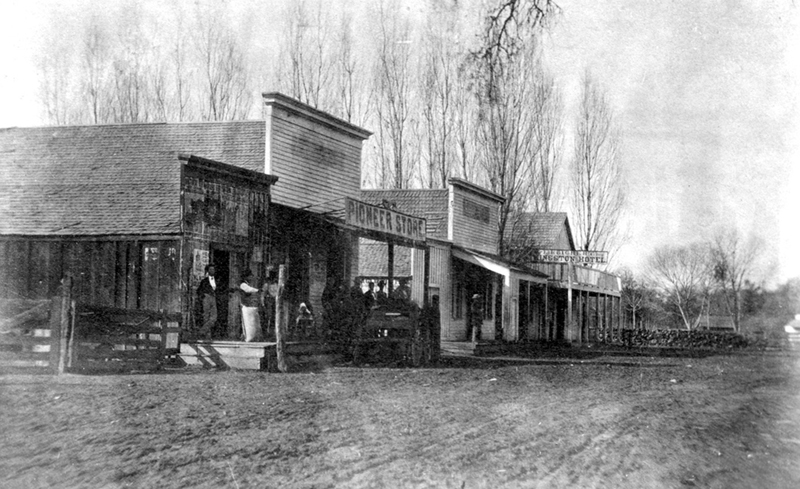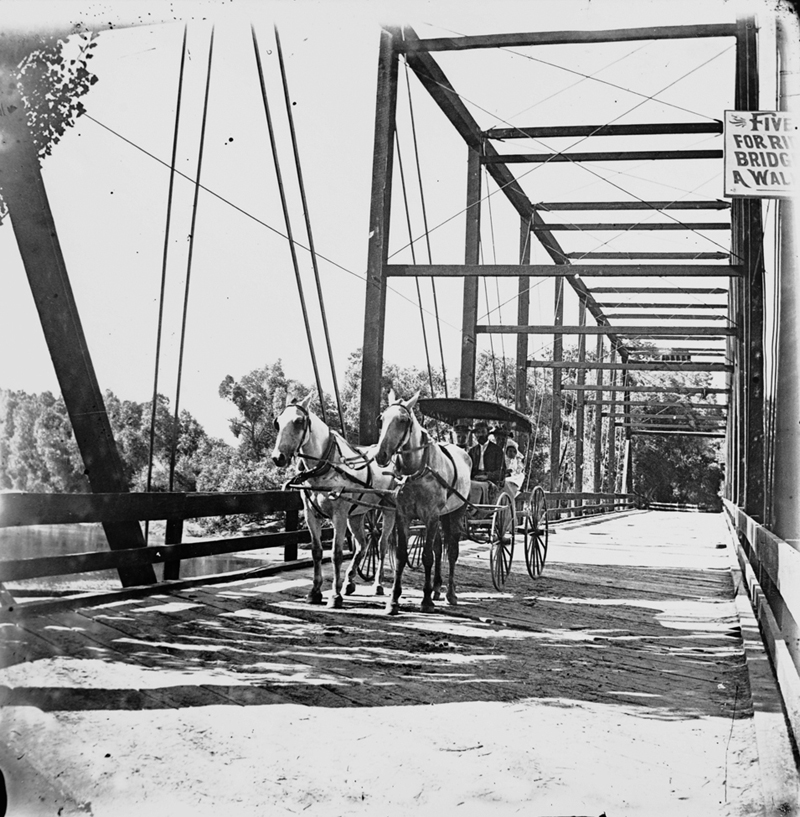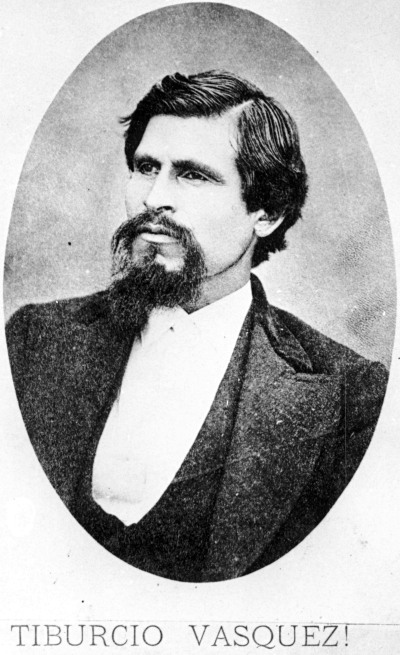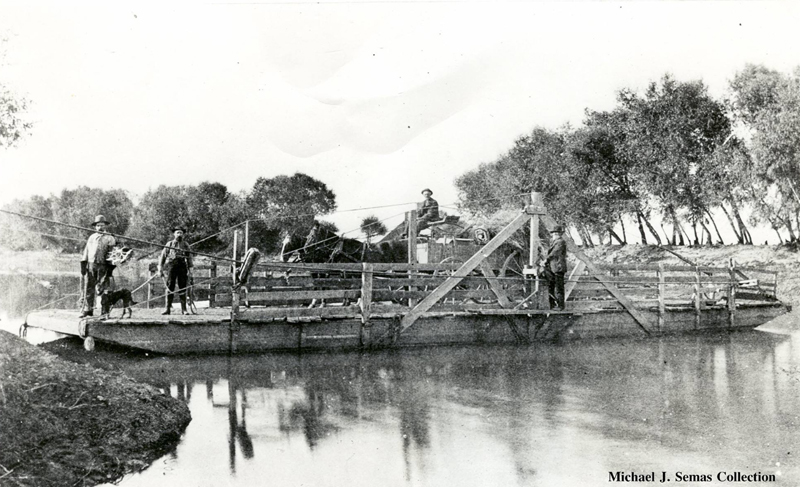|
|
Kings County, California
|
May 17, 2014 — Nine miles north of Hanford in California's Central Valley, nothing is left of Kingston — the town Tiburcio Vasquez and his outlaw gang brazenly raided the day after Christmas 1873 — except for some remnants of the bridge Vasquez used to ford the Kings River and some palm trees that may have been planted before the town died in 1890.
Originally an important commercial center between Stockton and Visalia, today Kingston is essentially just a grove of peach trees on the south side of the river across from the little town of Laton, which came later. On site, Kingston would be completely forgotten if not for a California Historical Landmark plaque (No. 270) placed in 1950 — but the plaque is located inside a county park that was closed in 2011. The park is in the 13100 block of Douglas Avenue, 0.4 miles west of 12¾ Avenue, aka Fowler Avenue. Kingston was part of Tulare County until 1856 when Fresno County was formed (although nobody knew it until 1859). Today the site is in Kings County, the land south of the river having been transferred in 1909. (Laton, north of the river, remains in Fresno County.) Kingston was initially called Whitmore's Ferry. Lucious A. Whitmore established a toll ferry across the river in about 1855 (accounts vary as to 1854, 1855 or 1856). Butterfield's Overland Mail Co. put the place on the map in 1858 when it erected a station at the crossing. The following year, Whitmore was shot and killed while trying to defend his Yokut wife from the U.S. Cavalry, which was rounding up Indians for transport to reservations. The town was subsequently renamed Kingston. Oliver Bliss bought Whitmore's ferry system at auction and won a (Tulare) county contract to operate it in 1859. He charged 75 cents for a horse and buggy or 25 cents to cross on foot, and lesser amounts for livestock. After some years (perhaps as late as 1872), he used the lumber from two ferry boats to build a bridge across the river. In 1873, a sturdier pile bridge with concrete footings replaced it. As for who built it, there are two versions: Either Bliss built it; or Bliss sold his ferry and bridge business in 1873 to John Sutherland, and Sutherland built it.
Either way, it was this brand-new bridge — all complete except for its gates — that Vasquez and his accomplices traversed on the evening of Dec. 26, 1873, when they tied up the townsfolk and robbed them blind. Historians in Laton tell the story this way (at latoncalifornia.org): Just after dark the bandit gang of the notorious Tiburcio Vasquez left their horses, under guard, north of the river and crossed the bridge on foot. Meeting Mr. Bliss near the bridge, they tied him and left him lying on the ground. He complained that he was not comfortable and one of the bandits took a blanket from a wagon and placed it under his head. They met and tied John Potts, Presley Bozeman, and Milt Woods — and robbed them, of course. They placed guards at the store of Jacobs and Einstein, at that of Solomon Sweet, and at Reichert's Hotel. In the barroom they tied down and robbed ten men, collecting about four hundred dollars. In the sitting room of the hotel, Ed Douglas of Visalia refused to be tied; but the bandit struck him on the head with a revolver, knocked him down and relieved him of his valuables. In the dining room a girl waitress screamed as one of the Mexican bandits entered. (Some of the gang were not Mexican.) Lancelot Gilroy, who was at the table, thinking that the man had insulted the girl, struck him with a chair and knocked him down. The bandit was soon up, and, swinging his revolver, dealt Gilroy a stunning blow on the head, which ended his resistence. According to one version, three members of the gang were in the clash with Gilroy.
A clerk in Jacobs and Einstein's store shouted an alarm, but by that time the bandits had the situation well in hand. They demanded the keys to the store safe. Einstein denied having them, but being threatened with death, he gave them up. The safe yielded eight hundred dollars. While they were looting the Sweet Store, a guard outside yelled that he had been shot. James W. Sutherland and James E. Flood, who lived near the village, had seen or heard things that made them suspicious. They collected a few men and went to investigate, but one man, in his excitement, fired prematurely the shot that sent the bandits on their way. They had collected twenty-five hundred dollars in money and jewelry in the little town. A posse of local men took up the trail the next morning, but the gang was not found. They caught one Mexican at the time, but ultimately at least three men served penitentiary terms for participation in the holdup. Vasquez, the leader, who was found guilty of many crimes, was captured about a year later in southern California. Although he was not regarded as a killer, he was convicted of murder — possibly the only murder of which he was guilty — and was hanged on March 19, 1875. (The murder for which Vasquez was convicted occurred precisely four months earlier, on Aug. 26, 1873, at Tres Pinos, southeast of Hollister in San Benito County.) Kingston went into decline and was abandoned by 1890 when the post office was transferred to Lillis (another ghost town), then to Laton in 1900. The Atcheson, Topeka and Santa Fe Railway Co. dealt Kingston a final death blow when it bypassed the old townsite, instead operating a line that ran to Laton as of 1911. Oliver Bliss' livery stable is considered to have been Kingston's last remaining building, standing until 1930 on the south bank of the river where the rubble of the (1873) bridge piles can be seen today, one-half mile west of the current Laton Bridge at Fowler Avenue. It should be noted, however, that in 1937 The Fresno Bee reported that the wood-frame home of Perry Phillips, built on the outskirts of Kingston when he arrived in 1860, was still standing. The 1937 news report concerned the forthcoming recognition of Kingston as a State Historical Landmark. (Registration occurred Sept. 3 of that year, but it's unclear whether a plaque was actually placed at that time. The current marker is dated Feb. 4, 1950.) The landmark plaque reads: "Kingston / Founded in 1856 by L.A. Whitmore, who operated the first ferry to cross the Kings River, Kingston became stopping place for Butterfield stages after 1858. A toll bridge superseded the ferry in 1873. On December 26, 1873, Tiburcio Vasquez and his bandit gang made a bold raid, robbing the entire village. / State Registered Landmark No. 270 / Tablet placed by California Centennials Commission / Base furnished by Kings County Centennials Committee / Dedicated February 4, 1950."
19200 dpi jpegs from ditigal images by Leon Worden. |
• L.A. Evening Express 12-29-1873 • Bakersfield Southern Californian 1-1-1874 
Raid Remembered 1-17-1937
|
The site owner makes no assertions as to ownership of any original copyrights to digitized images. However, these images are intended for Personal or Research use only. Any other kind of use, including but not limited to commercial or scholarly publication in any medium or format, public exhibition, or use online or in a web site, may be subject to additional restrictions including but not limited to the copyrights held by parties other than the site owner. USERS ARE SOLELY RESPONSIBLE for determining the existence of such rights and for obtaining any permissions and/or paying associated fees necessary for the proposed use.




